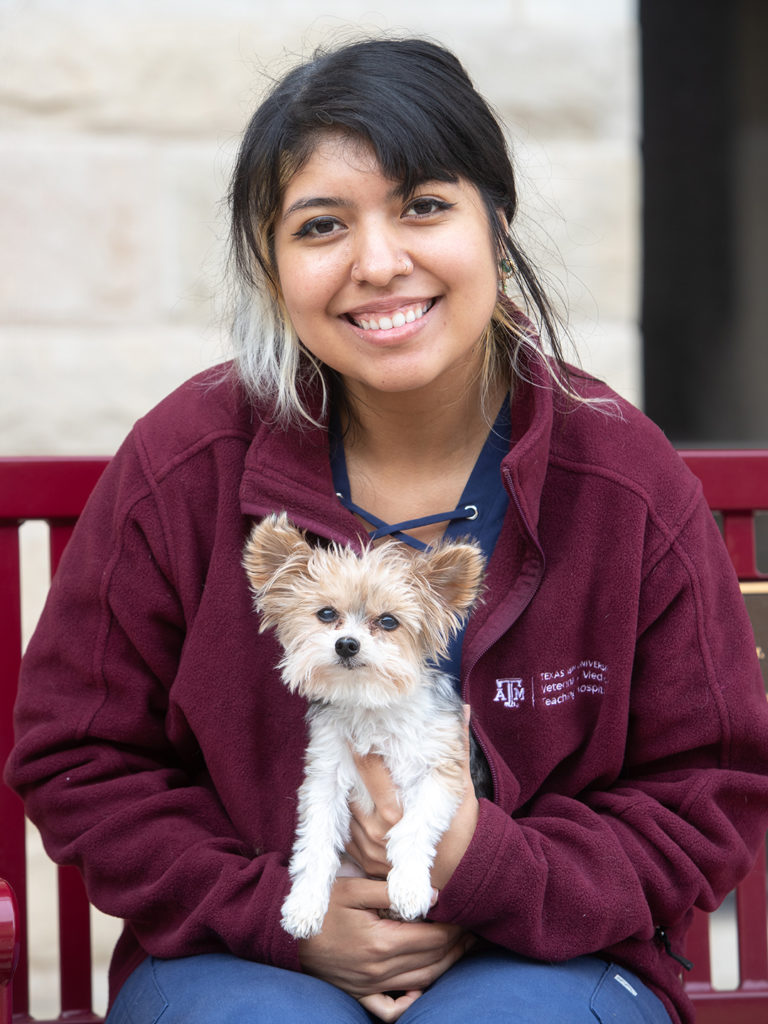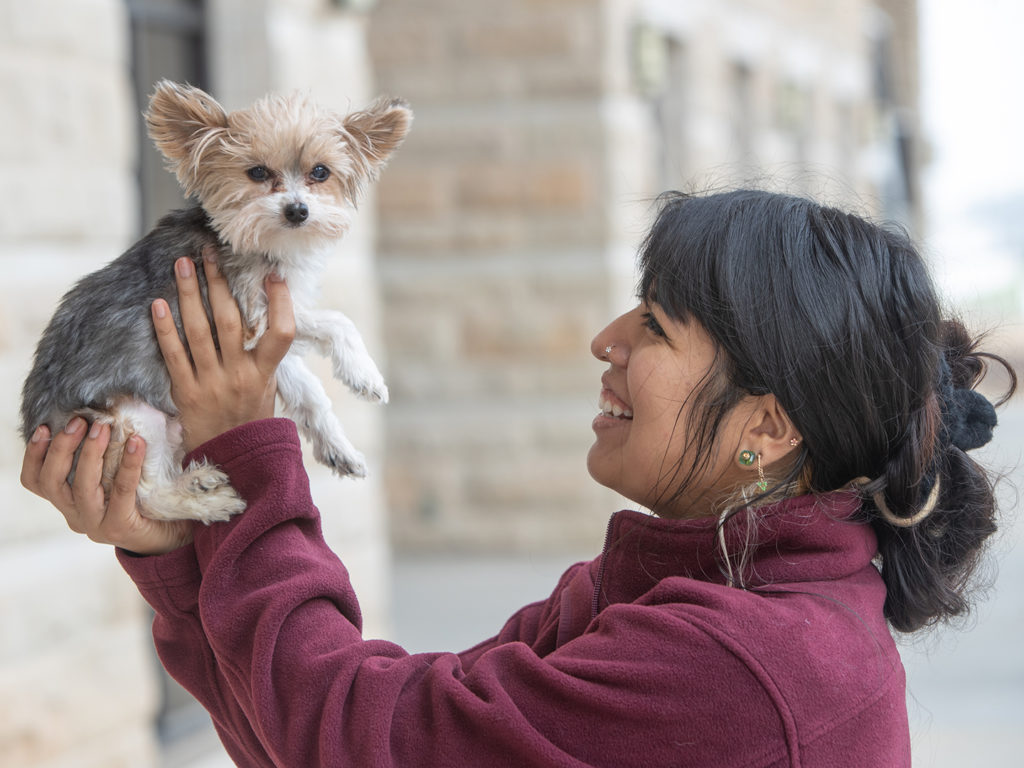Texas A&M Veterinarians Diagnose, Repair Rare Condition In DVM Student’s Yorkshire Terrier
Story by Rachel Knight, VMBS Communications

Danielle and Axel Villa’s relationship began with love at first sight.
Danielle was visiting a park in her hometown of San Antonio that was hosting an expo for dogs. When she came across a litter of 10 Yorkshire Terrier puppies, the runt of the litter caught her eye. She noticed he was alone in a corner and picked him up.
The two have been inseparable ever since.
Now, 14 years later, Danielle is a fourth-year Doctor of Veterinary Medicine (DVM) student at the Texas A&M School of Veterinary Medicine & Biomedical Sciences (VMBS).
Axel, her loving companion, has helped Danielle through the transition from her undergraduate studies to veterinary school and through the COVID-19 pandemic. So when Axel started having trouble urinating, it was Danielle’s turn to be there for him.
“We started with a Primary Care (Service) visit to the Texas A&M Veterinary Medical Teaching Hospital (VMTH),” Danielle shared. “I thought he might have a common urinary tract infection (UTI) because he’s an old man who suddenly needed to use the bathroom more often with very little coming out each time.
“Primary Care took great care of him. They ran some tests, discussed the results with me, and presented treatment options,” she said. “I chose to do some antibiotic treatment, because it seemed to be a UTI.”
After two weeks of antibiotic treatment, however, Axel’s symptoms were worse than before, which meant he did not have a UTI.
Axel was then referred to the VMTH Internal Medicine team, which continued to search for the cause of his pain. They conducted an ultrasound to check for blockages in the tubes that carry urine from the kidneys to the bladder but didn’t find one.
The case was then referred to Dr. Audrey Cook, a professor in the Department of Small Animal Clinical Sciences who specializes in internal medicine and is assigned to the Interventional Radiology and Endoscopy Service. She ordered another test.
“I was most worried because of his age about a tumor in his prostate or urethra,” Cook explained. “We did a contrast study, in which we put radiodense liquid into the urethra to see if there is a narrowing or blockage.
“To our amazement, we found that his bladder was essentially falling backwards into his pelvis, which then put a major kink in his urethra. It was dramatic but explained everything that his owner had described,” Cook said. “So, the more he tried to pee, the more he pushed his bladder backwards and the more he blocked off the flow.”
Cook explained that Axel’s diagnosis was tricky from the start, in part because his condition is rare.

“I have only seen this condition once before, that time in an older female yorkie, so it wasn’t really on my radar for Axel,” Cook shared. “Because the bladder slipped back and then forward, his signs weren’t consistent, which was confusing, and our ultrasound didn’t give us any hint of what was going on. He’s one of those cases in which you just have to keep an open mind and find creative ways to define the problem. We sort of have a step-by-step approach to dogs that can’t urinate, so the contrast study was the next logical thing to do for him.”
Axel’s diagnosis revealed a need for surgery.
“The diagnosis was hard, but the surgery was simple,” said Dr. Kelley Thieman, the Nancy & Michael Shaw ‘68 Chair in Small Animal Clinical Sciences, who led Axel’s surgical team. “We just pulled his bladder forward and tacked it to his body wall so that it stayed forward instead of sliding backwards and kinking off his urethra like a garden hose.”
Thieman sent Axel home with postoperative care instructions, and by that evening, Axel was already back to normal.
“I don’t think I had cried that hard in a long time,” Danielle shared. “It was such a relief to see him chipper and energetic again after a month of going through pain and not being able to sleep.
“Dr. Cook, Dr. Thieman, and the rest of the VMTH’s Primary Care and Internal Medicine teams took really good care of him,” she said. “I’m glad they were all there to work together and figure out what was wrong with him, even though it was a very uncommon thing.”
Danielle began pursuing her DVM degree as a way of paying forward the exceptional care her pets have received from their veterinarians throughout her life. She said Axel’s health care journey and the help he received from her mentors in the VMTH reinforced that desire.
“In veterinary medicine, you’re healing animals and working with their owners every day,” she explained. “When my pets have been sick, I’ve had veterinarians who were able to address my concerns and make me feel like my family member is safe in their care. I want to be able to do the same thing for people. I do my work both for the animals and for their family members, because their family members love them and they’re the ones taking care of them at the end of the day.”
As Danielle begins wrapping up her vet school experience, with only a few months until graduation, she said she looks forward to soon being able to offer to her clients and patients the same quality and compassionate care Axel received from some of her teachers and mentors and that she is grateful to them for helping Axel return to his happy, healthy self.
###
For more information about the Texas A&M College of Veterinary Medicine & Biomedical Sciences, please visit our website at vetmed.tamu.edu or join us on Facebook, Instagram, and Twitter.
Contact Information: Jennifer Gauntt, Director of VMBS Communications, Texas A&M College of Veterinary Medicine & Biomedical Sciences, jgauntt@cvm.tamu.edu, 979-862-4216


